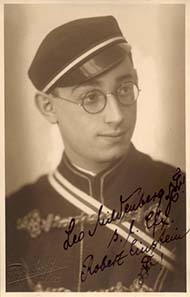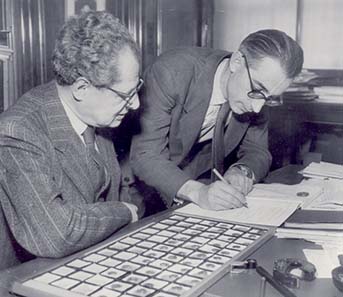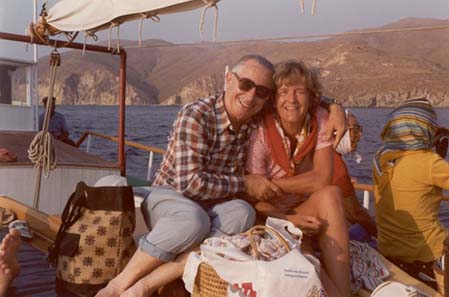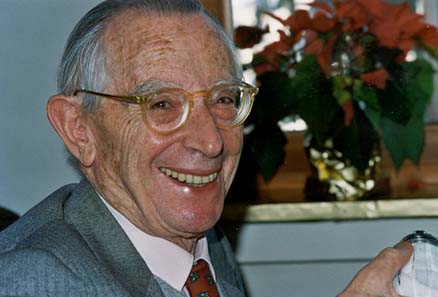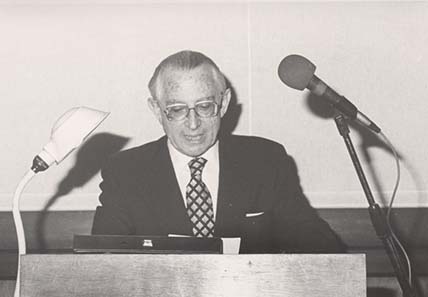Leo Mildenberg
A life devoted to coins – a life devoted to collectors – a life devoted to science
Bahnhofsstraße 1949. A man takes a walk. He stops at the window of the Bank Leu. Coins are on display, ancient coins, to be specific. One of them is wrongly identified. The man enters the bank, notifies the person responsible of the error and is appointed on the spot as numismatist in the gold department of the Bank Leu. That was how the career of Leo Mildenberg started, most likely the most famous coin dealer in the world.
Leo Mildenberg was born on February 14th, 1913, in Kassel / Germany. He grew up in Southern Germany. He was a Jew and proud of his Jewish heritage. He must have hit him hard when the spreading National Socialism forced him to abandon his studies in Ancient History and the Semitic languages in Germany and to flee to Estonia. There, at the University of Dorpat, he found a new home. Leo Mildenberg gained his doctorate and taught in Estonia until Soviet troops occupied the country. He did not count as Jew anymore but became a German whom the Soviets, together with all the other Germans, deported to a concentration camp in Kazakhstan.
Life was hard there – but Leo Mildenberg was one of those who survived the horror, perhaps thanks to the love he felt towards Elsi Brunner whom he married still in Kazakhstan. When the war was over, he accompanied his wife to her home town, Zurich. By chance, his skills as numismatist were discovered for the trade there and the career of the coin dealer Leo Mildenberg began.
During the Second World War, Switzerland had replaced Frankfurt as centre of the coin trade. – By tradition, the sale of ancient coins had been undertaken by Jews and the Jewish coin dynasties had removed their branches to Basel and Luzern, giving the attacks by the National Socialists. The Bank Leu, too, had to face the fact that many, for the most part Jewish, collectors wanted to sell their precious coins to finance a new start in their new home. Trade on a small scale had developed. After the war, Leo Mildenberg turned it into a profitable business carrying the name of the Bank Leu even to the most remote collector worlds. Leo Mildenberg took pride in being the first Jewish bank director in Zurich. He made it a habit of pointing out the fact that Leo meant the same as Leu – lion, that is.
The first auctions of the numismatic department of the Bank Leu Leo Mildenberg conducted together with the company Hess in Luzern. Since 1971, the Bank Leu published its own auction catalogues. Leo Mildenberg felt a special commitment to write them. He did not believe in a collection being built for eternity. The collections had to be continuously put together and dispersed again. But every collection contained its own special message to science. Leo Mildenberg thought it his task as an academic coin dealer to fix that message for future generations of scientists with a meticulously prepared catalogue.
Countless important coin collections were auctioned off under his aegis. And Leo did not only offer his customers the then spectacular objects. With the auction catalogue Bank Leu no. 6 from 1973, for example, the collectors of Greek coins became aware of the beauty of bronze coins which the common catalogues hitherto had not even illustrated. Or take the famous auction 17, silver coins of the Roman Republic. That auction catalogue is sought-after until the present day, and collectors are still inspired by the beauty of the pieces offered therein.
The eternal highlight, however, is the Kunstfreund auction Leo Mildenberg conducted in conjunction with the friendly competitor company Münzen und Medaillen AG, Basel. The catalogue issued on that occasion was a true novelty in those days. As in a coffee-table book, the photograph of the coin and the text were presented on a double page – what is taken for granted today was an unfamiliar luxury back then. Each piece was elaborately commented on. The result was: the coins of the Kunstfreund Collection brought maximum prices that held the record for nearly 30 years. The pedigree “from Kunstfreund” still marks the most beautiful coins a collector can possess.
Leo Mildenberg became the patron of entire generations of coin collectors, coin dealers and scientists. He had the unmatched talent to avoid showing off with his own expertise but to project on his counterpart the feeling that he, the counterpart, possessed a comprehensive knowledge with only the smallest gaps in need of being filled.
Many collectors know stories about him, how he kindly invited youthful, inconspicuous customers to inspect his storerooms all by themselves, and how he shooed posers all dressed up off his business premises without even eyeing their well-filled wallets. Leo Mildenberg was the driving force, adviser in the background of countless collectors who trusted his guidance and were stamped by his taste.
The MoneyMuseum likewise regards itself amongst those whose collections have been shaped by Leo Mildenberg. He was the mentor of Jürg Conzett, the carer of his coin collection; it was he who came up with the common thread, so vital for the development of the collection of the MoneyMuseum. He suggested to collect not according to eras but to assemble all big anchor currencies from two millennia of numismatic history.
An object from Leo Mildenberg’s dream collection.
Until the present day, his actions leave a trace on the internet. Leo entrusted the documentation of his “dream collection” to the MoneyMuseum. For more than 50 years, he had collected photographs of the most beautiful Greek coins he had encountered during his career. This collection, he said once when he gave a lecture, he would assemble himself if only he had the financial means. But he did not; and so Leo delighted in the illustrations and trained his eye since it is not always easy to recognize the artistic merit of a die cutter without being distracted by material, price and size of a coin. The coins of his “dream collection” spoke to him, some “sang” to his mind. Leo Mildenberg developed a personal relationship to the most beautiful of objects which he transmitted to his customers and his audience by his lively way of talking.
The greatest depiction of Zeus, father of the gods, for example, Leo Mildenberg did not discover in an auction catalogue but in the Brussels Coin Cabinet. He raved about Zeus shown on the reverse with the following words:
“I know that this is a masterpiece of Greek coinage. This is due to its remarkable details: the knotted stick as scepter, the pine and the eagle, the attribute of Zeus, the decorated thunderbolt in the left hand of the god, the transparent long garment falling from the shoulder, the modeling of the bare part of the upper body. But the true significance, in my opinion, lies in the modeling of the head, the facial expression: the master has managed to not merely create a realistic image of any man with a beard but to depict the father of the gods, Zeus himself. He looks as if he is dreaming.”
Leo Mildenberg did not restrict himself to the trade but continued to be an excellent scientist whom the numismatic world owes several important books. Be it in German or in English, his perspicuous and easily comprehensible language characterizes his works.
Leo’s particular interest was devoted to the Jewish past. His monograph on the coinage of the Bar Kokhba Revolt is used not only by numismatists – rather, it is still the best historical documentation of this complex period of Jewish history.
Leo Mildenberg dominated Greek numismatics; his studies, however, focused on neglected remote areas which hitherto had not really aroused much general interest. His profound knowledge yielded a new understanding and did the forgotten tradition of these long gone civilizations more justice. They were the losers of the battle with the Greeks and the Romans and hence were not able to bequeath their version of history. Leo Mildenberg gave them a part of that past back.
The overall image of Leo Mildenberg would be incomplete without his significant collection of ancient animal representations. Leo knew the collectors of coins because he himself was a keen collector. The pieces of his collection which were exhibited in museums worldwide are testimonies of his excellent taste. Panther and horse, hare and snake, hippopotamus and tortoise – Leo had no preferences, all animals were allowed in his arch as long as they were peaceful and wore neither reins nor bridle, neither rope nor shackle. This criterion perhaps reflects some of his life experience – the hope that humans, like the peaceful creatures in his collection, would one day live peacefully side by side, together, with no hatred, no envy, no violence, no war.
Leo Mildenberg died on January 14th, 2001. The numismatic world owes him incredibly much.
If you want to have a close look at the dream collection of Leo Mildenberg, please click here.







